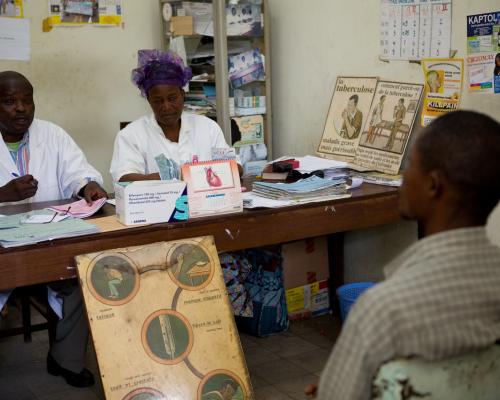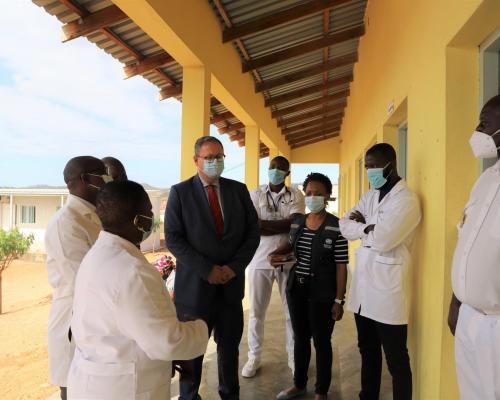Eswatini increases HIV preventative options to reduce new infections
The kingdom of Eswatini has made major strides in the HIV response with the goal of ending AIDS as a public health threat by 2030. The country is the first in the region to have accomplished the 95-95-95 treatment targets in 2020 with an associated steady decline in HIV incidence from 1.44 in 2016 to 0.62 in 2021 among adults (aged 15 years and older). This incidence is equivalent to about 4000 New HIV infections per year. The epidemic has shifted from what was traditionally known as a generalized epidemic to a micro-epidemic impacting different population groups in diverse ways. Adolescent girls and young women (AGYW), sex workers (SW), and men who have sex with men have a high vulnerability to HIV infection.
The country has developed a core set of proven effective HIV prevention strategies and aims to increase the uptake of high-impact services, such as condoms, HIV testing and counseling (HTC), prevention of mother-to-child transmission (PMTCT), antiretroviral therapy (ART), Post Exposure Prophylaxis (PEP), Pre-Exposure Prophylaxis (PrEP) and voluntary medical male circumcision (VMMC), according to the unique risks and vulnerabilities within each priority population. In particular, the use of PrEP has been scaled up over the years acting as a preventative measure against the spread of HIV. The Expansion of HIV prevention services including ART coverage (treatment as prevention) and the introduction of oral PrEP into the country, has contributed to the drop in HIV new infections.
In September 2015, the World Health Organization (WHO) recommended that people at substantial risk of HIV infection should be offered PrEP as a prevention method, and as part of a comprehensive package. In 2016, WHO’s initial role in the introduction of PrEP in Eswatini included providing technical guidance during in-country policy dialogues. WHO also supported the development of a National PrEP framework. PrEP was introduced in the country through a pilot study using the demonstration approach. At the time, the annual number of HIV new infections was estimated to be at 7000 according to the Eswatini HIV Incidence measurement survey conducted in 2016. The Ministry of Health (MOH) worked closely with WHO and partners including Médecins Sans Frontières (MSF) and Clinton Health Access Initiative (CHAI) to develop the study protocol and also mobilized resources to support the study implementation or demonstration projects. These were meant to assess the operationalization of PrEP as an additional HIV prevention method offered in public and private facilities. WHO support to the Ministry included the provision of technical support in developing an implementation framework to guide the demonstration projects and served in the core team coordinating the implementation of the pilot study. In 2018, the country introduced oral PrEP through the implementation of demonstration projects in 22 facilities to assess acceptability, feasibility and to monitor side effects and seroconversion for 18 months.
The results showed that offering oral PrEP to clients identified at substantial risk was feasible and acceptable in Eswatini. In addition, expanding access to PrEP encouraged more people to know their HIV status, provided an opportunity to discuss individual risks, and increased clients’ understanding and awareness of their HIV risk, offering further opportunities to provide expanded access to both HIV prevention services and, if a person tests positive, treatment services. Following these findings, WHO provided technical support to translate the findings into policy. In 2019, WHO technically supported the country to develop PrEP operational plans and guidelines including a monitoring framework as informed by the WHO global guidance and the findings from the demonstration projects.
In Eswatini, PrEP is offered to eligible, HIV-negative individuals who are at substantial risk of acquiring HIV infection. However, the following eight populations are prioritized: Adolescent girls and young women (16-24 years), pregnant and lactating women, serodiscordant couples, Sex workers, Men Who Have Sex with Men (MSM), clients with sexually transmitted infections (STIs), males (30-34 years) and transgender people. Eswatini moved away from giving PrEP to target populations to avoid stigmatization as was experienced in countries that introduced PrEP targeting key populations.
“I am not married and that is why I am on PrEP since I do not know the status of my partner. PrEP is okay and I take it every morning. I was told to take it days ahead of my boyfriend's visit. My family and stepmother know I use PrEP and I usually encourage my daughters to take it too since men would ask them for sex in return for doing them favors. The government has given us these drugs for free. The nurses even come to my home to bring me the tablets when I am unable to go to the clinic. I encourage Swazis, especially pregnant women to use PrEP because it will protect them and their unborn children. Also, ensure you eat before taking it so that you do not vomit and blame it on the drugs”
In 2019, the use of oral PrEP was scaled up in phases. PrEP implementation in Eswatini is integrated into community and facility-based services that are already providing sexual and reproductive health (SRH) and or HIV services, and which include both public and private sectors. During the process, WHO provided technical and financial support for the development of a national PrEP framework and implementation guide. WHO also supported the printing of these documents and monitoring tools (registers, monthly summary sheets, and appointment cards). Following the guiding documents, the WHO trained national trainers - about 30 mentors from the PEPFAR implementing partners ( MSF, EGPAF, ICAP, and URC) who are supporting the facilities in all four regions. The mentors thereafter trained healthcare workers in 100 facilities who are now providing PrEP. WHO also trained an additional 100 healthcare workers from non-PEPFAR supported sites including private facilities. Over the years, the number of facilities providing PrEP services increased from 22 in 2017 to 204 in 2022 (Figure 1). Similarly, the number of PrEP users is also on the rise from 2,200 in 2018 to 32,750 clients in 2022 surpassing the 2022 target of 20,000 clients (HMIS data, MOH 2023)
“The training has been helpful. So far, we have trained and mentored 65 facilities in the Hhoho and Shiselweni regions including public, mission facilities, and armed forces facilities, “ Gezani Mamba, HIV, Senior advisor at EGPAF
The mentors have also been trained on using the WHO PrEP App which acts as a general guideline and reference for PrEP.
“The App is more of support for us mentors who are constantly looking for updated information on PrEP from the app. We get up-to-date WHO recommendations on PrEP. It is quite easy to use and highly informative” Gezani Mamba.
In 2021, WHO recommended the use of event-driven PrEP for at-risk men. WHO technically guided the inclusion of this dosing schedule in the National Integrated HIV guidelines and PrEP implementation guide. WHO further supported with training of the non-PEPFAR supported sites and private facilities on Event Driven PrEP (ED-PrEP).
The country is currently conducting a pilot study on the introduction of the Dapavirine Vaginal ring in six facilities. Before the pilot, the Ministry of Health with support from WHO and implementing partners, conducted a stakeholder engagement to determine the acceptability of this product. PrEP is currently available in an oral fixed-dose combination tablet; this framework is meant to be inclusive of all future biomedical interventions, such as an implant, a vaginal ring, and or injectable PrEP which will provide more preventative options for women to prevent them from contracting HIV.
The MOH with support from WHO and other partners including U.S. President’s Emergency Plan for AIDS Relief (PEPFAR) and MSF has plans to further expand the PrEP options to include injectable PrEP in 2024. The strong political will and leadership from the government, with priority given to evidence-based programming and WHO recommendations and well-coordinated support from partners and key stakeholders including civil society organizations and communities, is what has led to the successes that have been achieved thus far. Over the years the HIV incidence has dropped from 14,000 in 2010, to 7000 in 2016 to 4,800 in 2021, and is projected to further decline to 4,300 in 2023. This data shows that Eswatini is on track to reach her vision of zero new HIV infection status by 2030.


